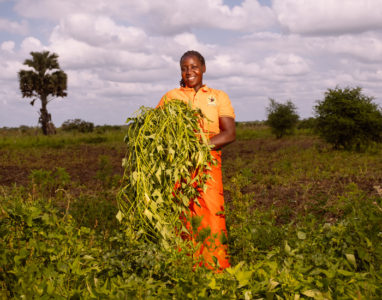Sweetpotato, the world’s sixth most important food crop, has great potential for improving food and nutrition security. The International Potato Center (CIP) has spent more than a decade promoting consumption of pro-vitamin-A, orange-fleshed sweetpotato in sub-Saharan Africa (SSA) and helping national programs develop and release about 150 resilient and fast maturing sweetpotato varieties through regional breeding platforms in Uganda, Mozambique and Ghana. However, a limited capacity to produce quality planting material has created bottlenecks that hinder efforts to get those varieties to farm families at risk of malnutrition or hunger.

CIP is working with national agricultural research institutes to enhance their capacity to produce and disseminate clean planting material of improved sweetpotato varieties. This process starts with the production of early generation seed – disease free vine cuttings classified as pre-basic or basic seed – which can be multiplied in the field to produce quality planting material for sale to farmers.
Production of pre-basic seed takes place in screenhouses and requires soil sterilization to keep planting materials pest and disease free, all of which is expensive. Researchers have thus tested the feasibility of using ‘sandponics’ as an alternative to the conventional soil-manure-and-gravel substrate for pre-basic seed production. In sandponics, plants are grown in pots of sterilized sand irrigated with a nutrient-rich solution.
A recent study by scientists from CIP and national institutions in several SSA countries demonstrated that sandponics can be a cost-effective alternative to the conventional method for producing pre-basic sweetpotato seed. Sandponics is less expensive because it uses san – widely available and cheaper than the traditional substrate – as the medium for growing the plants that cuttings are taken from. Sand can be sterilized using bleach and can be recycled. It also significantly reduces the costs of tissue culture propagation.
While testing the sandponics systems, the researchers optimized the nutrient solution used for irrigation. They found that the vine multiplication rate for pre-basic seed in a sandponics system was 22 percent higher than in the conventional system. And when sandponics-grown vine cuttings were planted in the field, they produced higher yields – 7.1 tons more per hectare – than planting material from a conventional system.
“Sandponics is an important innovation that increases sweetpotato vine multiplication rates and is cost-effective compared to the conventional soil substrate method,” said Phabian Makokha, the study’s lead author.

Nevertheless, Makokha and colleagues found that sandponics is more cost-effective for some sweetpotato varieties than others, so institutions need to identify which varieties the system is appropriate for.
Makokha noted that sandponics is ideal for areas with diminishing forest soil reserves, and where sterilization using diesel or firewood is expensive and environmentally unsustainable.
The researchers recommend further studies to evaluate the vine multiplication rate for the next generation of basic seed using planting materials sourced from sandponics systems; the use of sandponics for growing different varieties in experiments that include climate change modeling; and more design options for sandponics systems, such as planting in benches and troughs to optimize plant density.
This research included the participation of the Kenya Plant Health Inspectorate Service – Plant Quarantine and Biosecurity Station at Muguga, Kenya; the National Crops Resources Research Institute at Namulonge, Uganda; the Bvumbwe Agricultural Research Station in Malawi, and the Mansa Research Station in Zambia.
For additional information, consult:
(BRIEF) Pre-basic sweetpotato vine multiplication using a sandponics system
